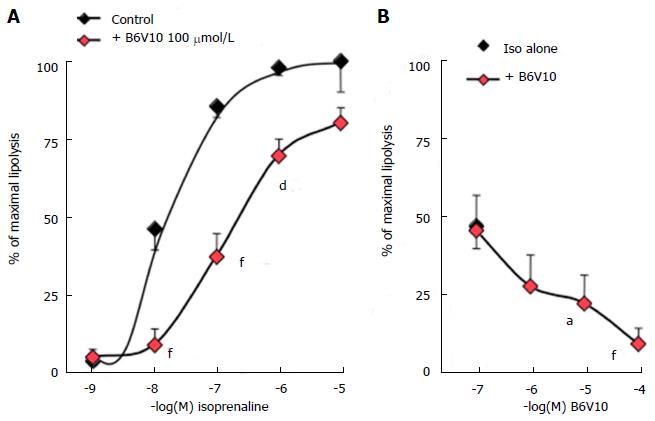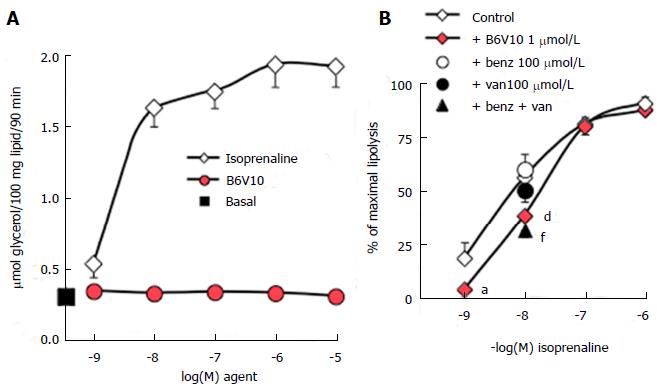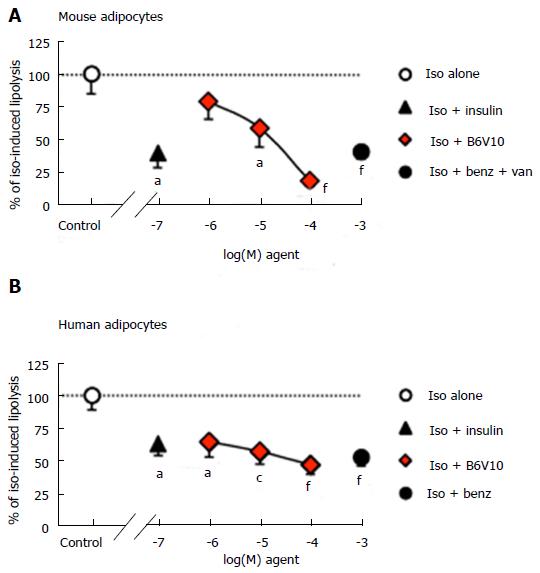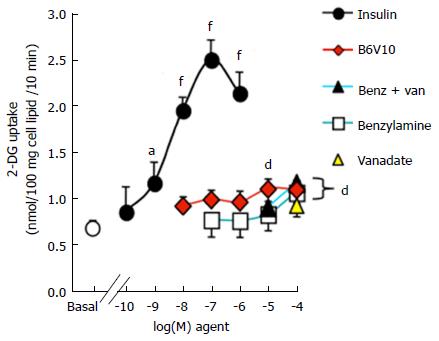Copyright
©The Author(s) 2017.
World J Diabetes. Apr 15, 2017; 8(4): 143-153
Published online Apr 15, 2017. doi: 10.4239/wjd.v8.i4.143
Published online Apr 15, 2017. doi: 10.4239/wjd.v8.i4.143
Figure 1 Influence of B6V10 on isoprenaline-induced lipolysis in rat adipocytes.
Glycerol release was determined in rat fat cells incubated 90 min without (basal) and with increasing concentrations of isoprenaline alone (control, black symbols) or with the indicated doses of B6V10. Basal lipolysis (0.39 ± 0.06 μmol glycerol/100 mg lipid/90 min) was set at 0% while maximal lipolytic effect of 10 μmol/L isoprenaline (1.73 ± 0.14 μmol glycerol/100 mg lipid/90 min) was set at 100%. A: Antilipolytic effect of 100 μmol/L B6V10 (red diamonds) on dose-dependent activation by isoprenaline; B: Dose-dependent inhibition by B6V10 of the lipolysis induced by 10 nmol/L isoprenaline (iso alone). Mean ± SEM of 8-10 determinations. Significantly different from corresponding condition without B6V10 at: aP < 0.05, dP < 0.01, fP < 0.001.
Figure 2 Influence of B6V10 on basal and isoprenaline-stimulated lipolysis in mouse adipocytes.
Glycerol release was determined after 90-min incubation of mouse fat cells without (basal, closed square) or with the indicated concentrations of isoprenaline (open diamonds) or B6V10 (red symbols). A: Lack of lipolytic effect of increasing doses of B6V10 (red circles); B: Comparison of the inhibition of isoprenaline-stimulated lipolysis by 1 μmol/L B6V10 (red diamonds), 0.1 mmol/L benzylamine (open circle), 0.1 mmol/L vanadate (closed circle), or their combination (closed triangle). Mean ± SEM of 8 determinations. Significantly different from corresponding control at: aP < 0.05, dP < 0.01, fP < 0.001.
Figure 3 Comparison of the antilipolytic effects of B6V10 and insulin in mouse and human adipocytes.
Lipolysis was activated by 10 nmol/L isoprenaline and considered as a control set at 100% (iso alone, dotted line) while basal was set at 0% in: Mouse adipocytes (A) or human adipocytes (B). The observed lipolytic response to the β-adrenergic agonist was significantly reduced in the presence of insulin (100 nmol/L, closed triangle), benzylamine (1 mmol/L alone for humans, or combined with 0.1 mmol/L vanadate for mouse adipocytes, closed circle), or increasing doses of B6V10 (1-100 μmol/L, red diamonds), at: aP < 0.05, cP < 0.02, fP < 0.01. Mean ± SEM of 8 murine preparations (A) or 6-7 individual cases (B).
Figure 4 Antilipolytic action of B6V10 in human adipocytes depends on prior lipolytic activation.
Lipolysis was activated by: Increasing doses of isoprenaline (A) or high dose of atrial natriuretic peptide (ANP) (B), and without or with the indicated doses of B6V10 (red symbols). Mean ± SEM of 6 determinations. Significantly different from corresponding condition without B6V10 at: aP < 0.05.
Figure 5 Activation of glucose transport in human adipocytes by supramicromolar doses of B6V10.
Suspensions of human fat cells (17 mg/400 μL) were incubated 45 min without (basal, open circle) or the indicated concentrations of insulin (closed circles), B6V10 (red diamonds), benzylamine (open squares), and 100 μmol/L vanadate alone (yellow triangle) or in combination with benzylamine (closed triangles), then [3H]-2-deoxyglucose uptake was assayed on 10-min period. Mean ± SEM of 10 adipocyte preparations. Significantly different from basal uptake at: aP < 0.05, dP < 0.01, fP < 0.001.
- Citation: Carpéné C, Garcia-Vicente S, Serrano M, Marti L, Belles C, Royo M, Galitzky J, Zorzano A, Testar X. Insulin-mimetic compound hexaquis (benzylammonium) decavanadate is antilipolytic in human fat cells. World J Diabetes 2017; 8(4): 143-153
- URL: https://www.wjgnet.com/1948-9358/full/v8/i4/143.htm
- DOI: https://dx.doi.org/10.4239/wjd.v8.i4.143

















